Rumford Recipes Sliding Cookbooks

Except for the Date Sticks the recipes aren’t impressive (so far). But the presentation is fascinating.
I have no idea how recipe-based advertising campaigns were designed in the heyday of promotional recipe books at the beginning of the twentieth century. One of the best such recipes I’ve seen is a Dromedary/Hills Brothers recipe for maple coconut candies, which I’ll be talking about later when I get to some of those cookbooks. It was one of three recipes in an ad for their Dromedary Fresh Keeping Cocoanut, a coconut-in-a-can product.1 It’s an amazing candy, and yet I’ve never seen it in any of the contemporary Dromedary cookbooks. Did they have separate recipes for their ads? If so, how would they choose which goes in a book and which in an ad? Would they use their best recipes in the ads or in the cookbooks?
Presumably, they had their own ideas about advertising. And, like oven terminology their ideas were different than ours in profound ways. One of the most fascinating relics of the era are these two sliding recipe cards from the Rumford Company. Recipes for Cake and Cookie Making is from 1926, and Recipes for Biscuits, Muffins, Rolls, Etc. doesn’t have a copyright date but, judging from the code, is from 1929.
The cards slide up and down inside a sleeve with a window on the front and back. Ingredient quantities are read on the front from a list of common ingredients, and the instructions are read on the back. I’ve retyped the recipes into a cookbook called Rumford Recipes Sliding Cookbooks (PDF File, 2.8 MB) (also available in print), but their original format has some interesting effects not possible in such a reproduction. The original encourages memorizing standard methods of baking—summarized in the “General Rules” on each slider—and thus learning common techniques for the same ingredients across different recipes. The “General Rules” are more of a recipe instruction than the recipes themselves, which are limited by the size of the slider’s rear window.
The one-line-per-recipe slider also emphasizes the commonality between very different baked goods. They are the same ingredients varied only in ratio and perhaps a few special add-ons. A Sugar Cake and a Spice Cake, for example, are the same thing in different amounts. This is obvious on the sliders, less so in a book like mine.
By their nature these aren’t fancy recipes. Given the constraints of a limited set of ingredients and a very small window of instructions—a literally small window—these are basic recipes, meant to be expanded on.
Something that bolsters my conjecture that this is as much a teaching tool as a sales tool is that while all 25 recipes in Biscuits, Muffins, Rolls, Etc., call for Rumford Baking Powder, twenty out of the twenty-five recipes in Cake and Cookie Making do not. While Rumford’s star product was baking powder, Rumford also made corn starch and baking soda, so that’s not as surprising as you might think. However, three of the Cake and Cookie Making recipes—the Brownies, the Almond Squares, and the Angel Cake—don’t call for baking soda or corn starch either. Corn starch isn’t listed as a standard ingredient on either slider; only one of the recipes calls for cornstarch2 in the “special ingredients” window: the Parker House Rolls in Biscuits, Muffins, Rolls, Etc.
The Angel Cake is interesting because it uses an older, pre-baking powder method of making cakes rise: load it up on beaten egg whites. It also isn’t necessarily appropriate to put in the list of non-Rumford ingredient recipes, because it does call for cream of tartar, which while not mentioned on these sliders is, I think, something Rumford did make. But it is exactly the kind of fiddly recipe that baking powder—which these sliders are explicitly promoting—was supposed to make easier!
Because I expect most people aren’t going to make a slider of their own, I’ve retyped the recipes into a simple PDF and ePub file. However, I’ve made the scans available if you’re feeling crafty enough to attempt a rebuild of the slider (Zip file, 2.6 MB).
Recipes for Cake and Cookie Making in four parts
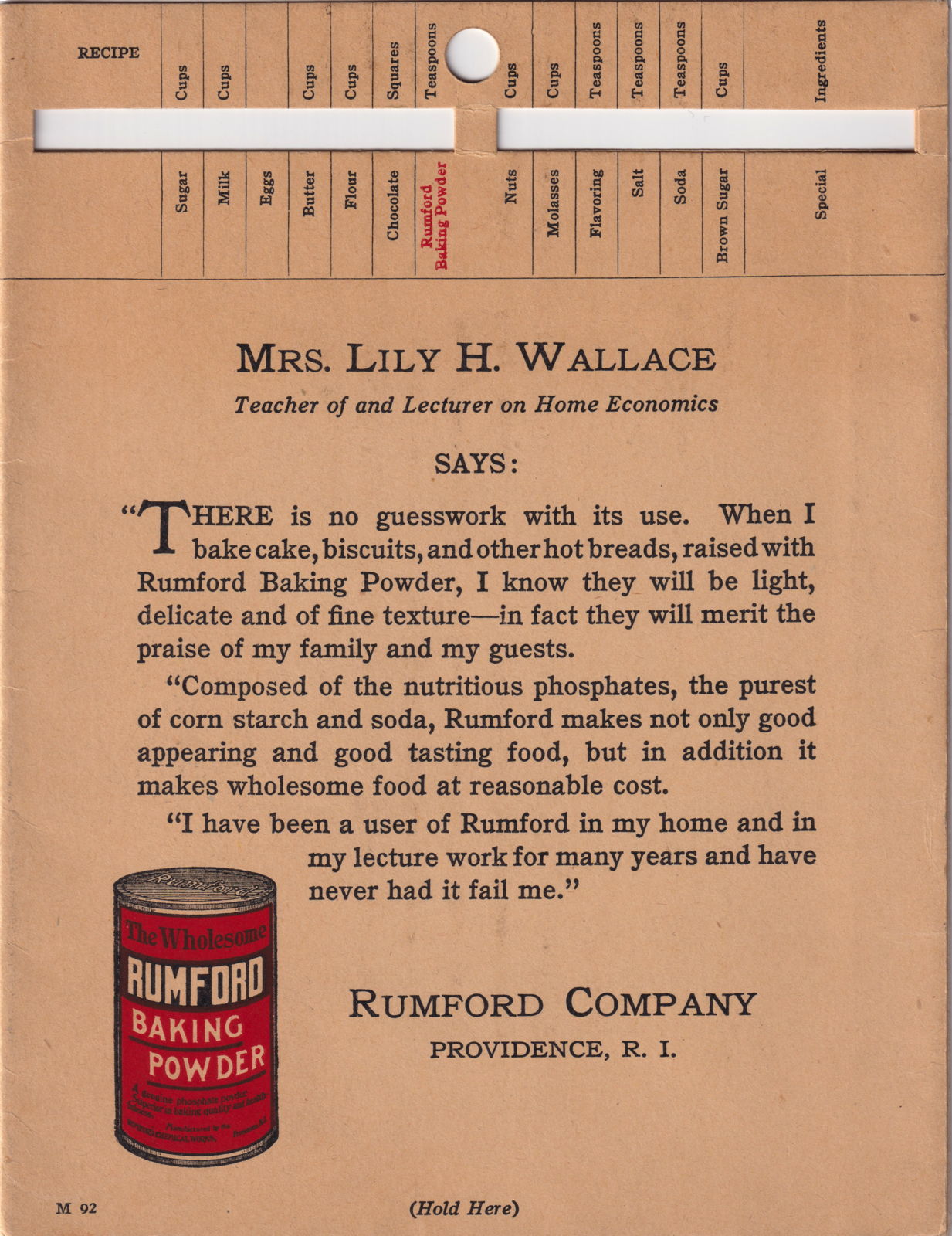
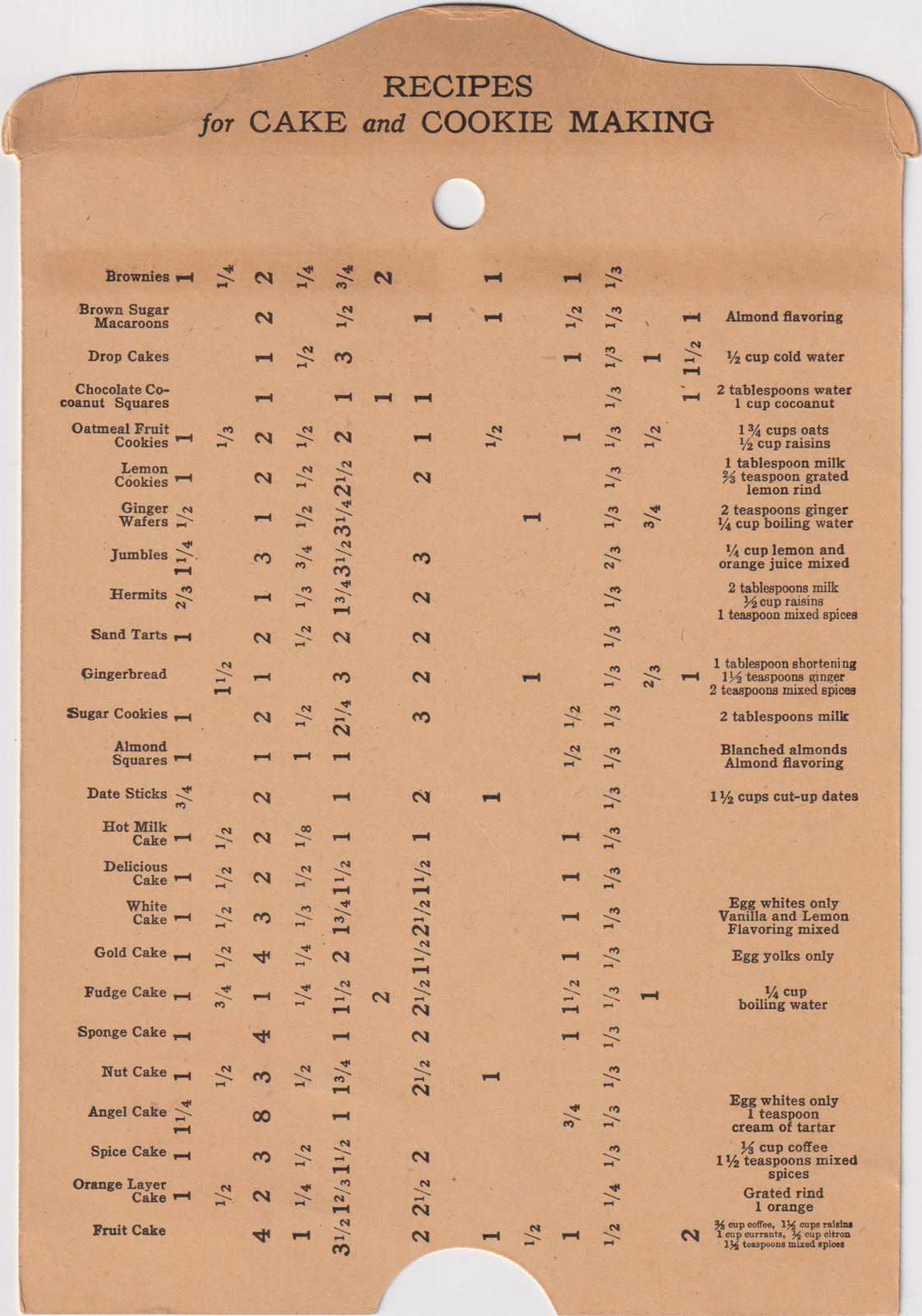

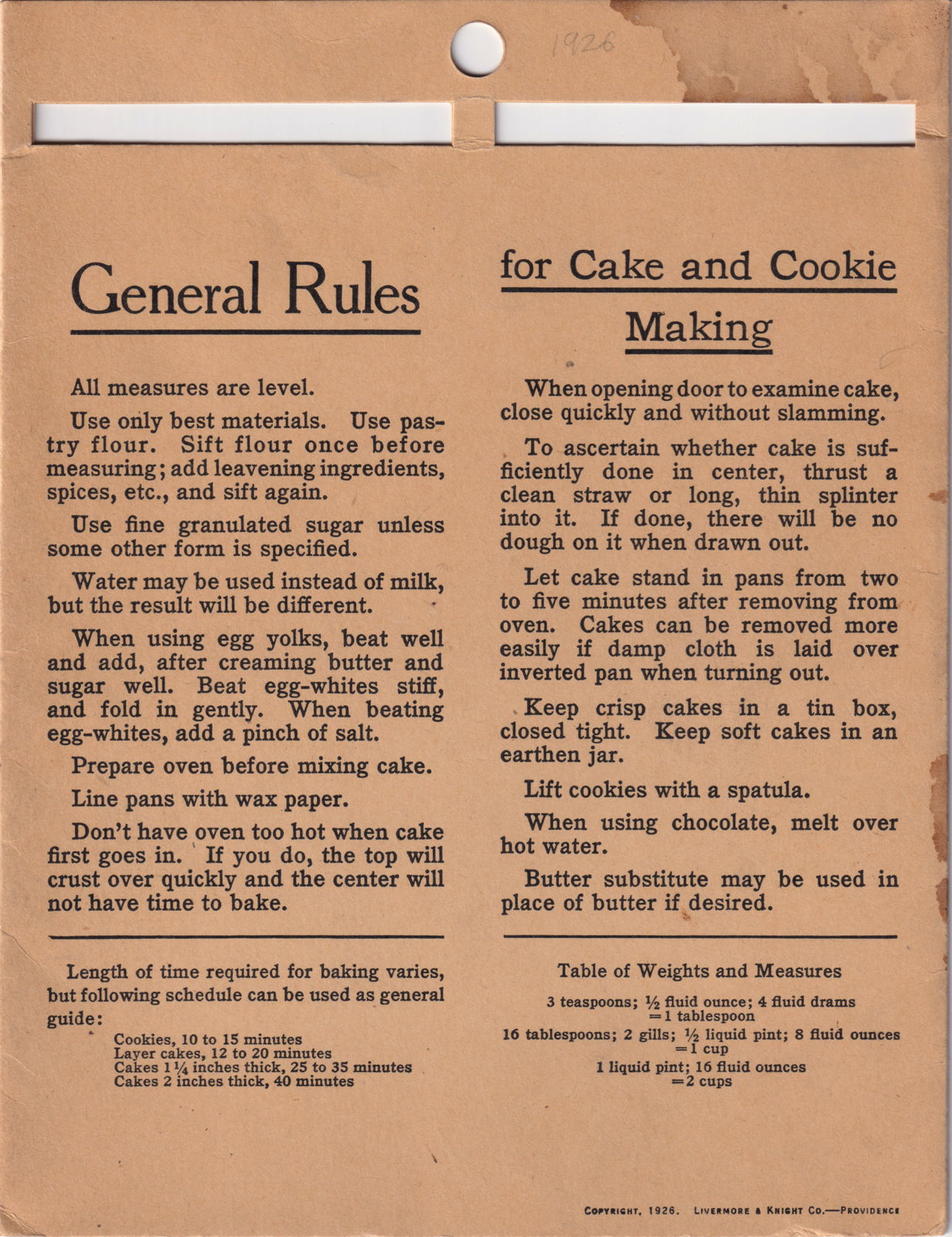
Also due to the format, I suspect, some recipes assume that the title of the recipe is part of the instructions. Whole Wheat or Graham Muffins does not mention using either whole wheat or graham flour. Neither do the potato flour muffins mention potato flour. You are—I think—supposed to recognize that you need to use the flour mentioned in the title.
But are you supposed to know whether there is a ratio involved? I suspect that there is no ratio: I suspect the whole amount is whole wheat flour, graham flour, or potato flour. If there were a ratio, it would have to be explicit. But I’m far from certain, especially concerning the potato flour muffins. Are they nothing but potato flour? Will the three stiffly-beaten egg whites provide enough structure and additional rising power to make up for a lack of gluten?
Sort of, I think. But what they won’t necessarily make up for is a substitution I made. According to King Arthur flour you can use instant potato flakes interchangeably, by weight, with potato flour. According to King Arthur potato flour weighs 1-⅝ oz per ¼ cup. So, ¾ cup would be 4-⅞ ounces. On a digital scale this will be 4.875 ounces, or, if your scale is like mine, between 4.85 and 4.90.3
Having made these biscuits twice now, I suspect there’s more to it than that. I suspect that I may be using a very restrictive definition of “muffin” and don’t really know what a muffin was to them, or even if “muffin” was used as a sort of joke, or ironically, based on the tin used to make these. The first time I made them, I used mashed potato flakes straight, using just the scale to measure. They had a great flavor—I like potatoes—but they didn’t rise as much as I would expect given the amount of egg white and baking powder in them. This matched what I expected from the consistency of the batter: it was much more thick than I would expect for a muffin. Finally, given their density, a slow oven—I used 300°—for only 25 minutes seemed awfully short.
The second time I made them, I first ground the flakes into powder. This in fact matched the weight given by King Arthur: a quarter cup was 1.6 ounces. I had exactly a quarter cup of flour after grinding all of the remaining flakes in the box, so I made a one-third recipe. I decided to go for a consistency I thought appropriate for muffins. This meant adding an extra seven tablespoons of water! For a full recipe, that would have been twenty-one extra tablespoons, over a cup and a quarter extra water.
I also baked them, this time at 325°, until they turned golden brown on top, which turned out to be 35 minutes. They turned out much better this time, but still a bit dense and not very muffin-like.
To test my King Arthur-inspired assumptions, I made a recipe from Beatrice Trum Hunter’s Whole-Grain Baking Sampler that I've been meaning to try, her potato flour cookies. They made cookies as expected, so I’m not sure what’s up with the Rumford recipe. I suspect that when they say “potato flour muffins” they mean making potato patties in a muffin tin. While these are a bit dense for muffins, they’re quite light and tasty for potato patties!
If I make them a third time, I might triple the amount of baking powder.
After grinding the potato flakes to flour, it took about 1 cup of the result to get the correct consistency for drop cookies, maybe a little more. This took about 2 cups of flakes. The “maybe a little over” is because it took a minute or so to stiffen up, and it’s possible I didn’t need to add the extra “or so”.
I forget who said it, but these cookies are amazing in the way that a dog walking on its hind legs is amazing. It doesn’t do it well, but it’s surprising that it’s done at all. They’re cookies, and they look like cookies, and they taste like potatoes with the inside consistency of mashed potatoes. Almost like eating a fried potato patty with a little syrup on it. Although far from great, it does taste good, and it tastes interesting, but it doesn’t taste interesting in a good way.
If that makes any sense. I’d make these cookies only if the idea of mashed potato cookies appeals to you.
It’s possible, then, that the Potato Flour Muffins are meant simply to make potato patties more easily and regularly in a muffin tin. They would, I suspect, be great as the bread for biscuits and gravy.
I also tried the Brown Sugar Macaroons, and they’re a good example of why the General Rules are important. The General Rules say to use wax paper. So my macaroons were a bit scrunched from removing them with a spatula. They were otherwise a perfectly fine old-school macaroon.
The Date Sticks were much better. They were the highlight of the recipes I tried. I initially thought there must be something wrong with the recipe. There wasn’t enough liquid to incorporate the “cut-up” dates, let alone the sifted dry ingredients. The egg white at the end barely held the “batter”, such as it was, together. I was thinking I might have been better served by fully grinding the dates along with the nuts.
Once baked, however, and given time to cool, they came out very much like biscotti. They were well-suited for dipping into coffee the next morning, nicely crunchy with chewy date bits throughout. Of the three recipes I’ve tried so far, this is the only one I’ve added to my rotation.
The minor changes in terminology across these sliders is also interesting. There was obviously no hard-and-fast style guide in use at Rumford. The Biscuits slider used the hyphenated phrases “egg-whites” and “egg-yolks”. The Cakes slider did not hyphenate those phrases, except in the general instructions where it hyphenated egg-whites but not egg yolks! Biscuits also used both “cornmeal” and “corn meal”, and in the same recipe (salad sticks, corn bread) almost as if the front (ingredient list) and back (instructions) were written by different people with different terminology! But the spoon bread recipe used “cornmeal” on both sides.
The choice of units might have been influenced by the format. The recipes often call for amounts such as “6 teaspoons” where we would normally see “2 tablespoons”. That’s just because most recipes needed teaspoon amounts, and so that’s how the window was labeled. Oddly, the authors did not write “8 tablespoons” of sugar in the Rumford Tea Ring recipe, instead putting “½ cup” in the number box. That same recipe also called for ⅞ cups milk, which is a rarely seen fraction. Normally it would probably be ¾ cup plus a tablespoon. Do these decisions indicate a lack of standardization on cups vs. tablespoons in the late twenties? The back of the Biscuits slider specifically says to use standard measuring cups but makes no mention of teaspoons and tablespoons. If they’re not standard, that would make the ratios in these recipes very iffy. But that would also make the “Table of Weights and Measures” wrong. So who knows what’s going on here.
Relatedly (I suspect) all of the recipes in Biscuits, Muffins, Rolls, Etc., call for a generic “shortening”. Cakes and Cookie Making instead has “Butter” in its list of standard ingredients. The recipe for Gingerbread lists no butter but does have shortening in its special ingredients. The Ginger Wafers recipe calls for ½ cup butter and instructs the baker to mix the “shortening” where all other recipes describe creaming the butter.4 Does this mean that Ginger Wafers do not use butter? Or is this an example of using the term “shortening” to refer to any fat? I suspect the latter, and that the reason the one uses the butter column for shortening and the other doesn’t, isn’t the ingredient but the measurement. The Ginger Wafers recipe calls for a shortening amount measurable in cups, which matches the ingredients column. The Gingerbread calls for it in tablespoons, which does not.
If you just want the recipes, you can download the PDF (PDF File, 2.8 MB), the ePub (ePub ebook file, 2.5 MB), or buy a booklet reproducing the recipes but not the format. As I wrote earlier, you can also build it yourself (Zip file, 2.6 MB) if you’re craftier than I am.
Recipes for Biscuits, Muffins, Rolls, Etc. in four parts
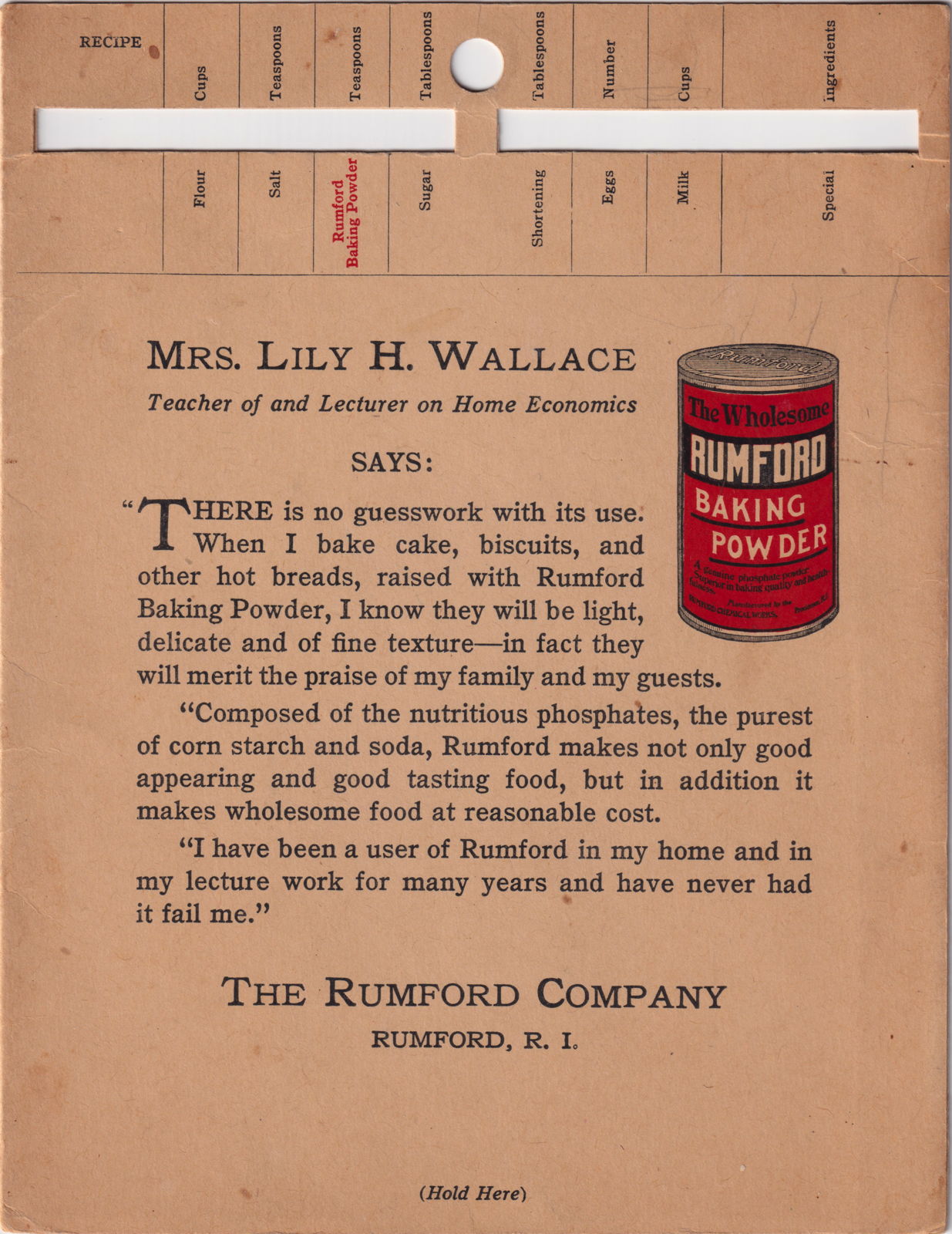
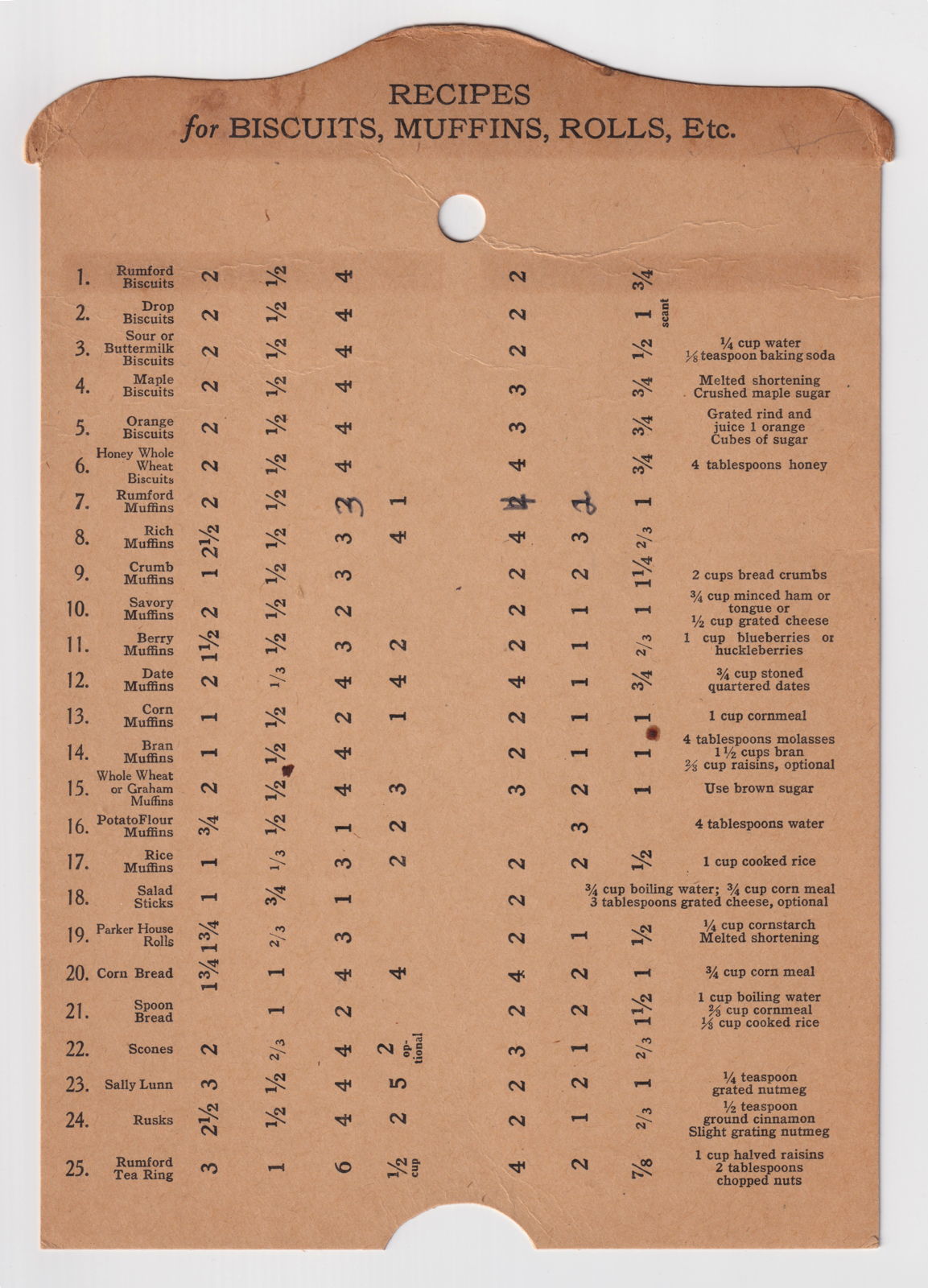

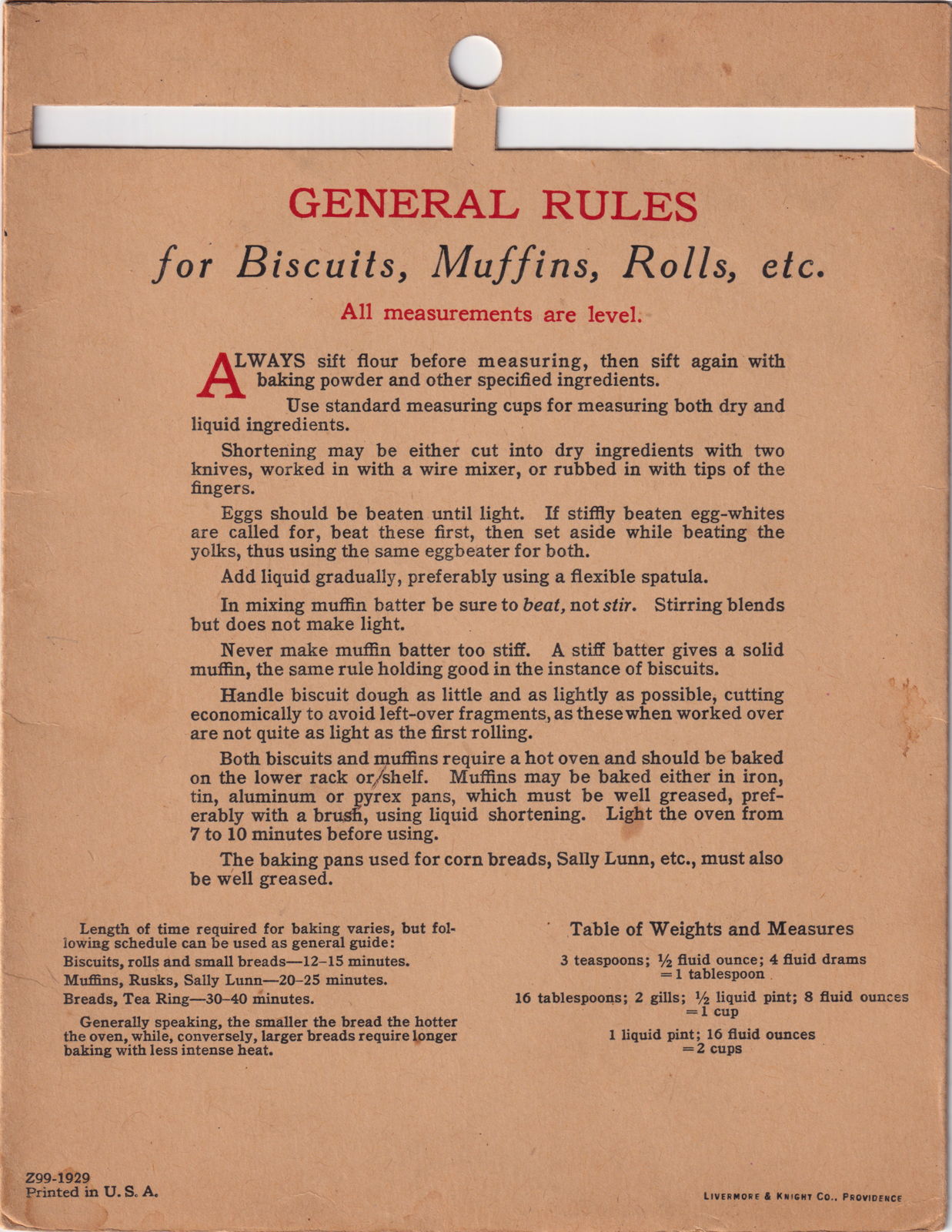
Rumford was apparently a successful company: their address changed from Providence, Rhode Island in 1926 to Rumford, Rhode Island, in 1929. It looks like they made a combined edition in the thirties. The steps and ingredients are on the same side in that version. One side contains “quick breads” and the other “cakes, cookies, donuts, etc.”. Some of the recipes look to be the same. Some do not. This innovation makes a lot more sense than having to turn the slider over to see the instructions, but that version also seems to be rarer. Whether this is because it was used more often so that it fell apart, or it wasn’t as popular and so wasn’t printed in the same quantities, is hard to tell. It isn’t difficult to find the older front-back sliders today, but I’ve only seen the combined slider once.
Notes on the recipes:
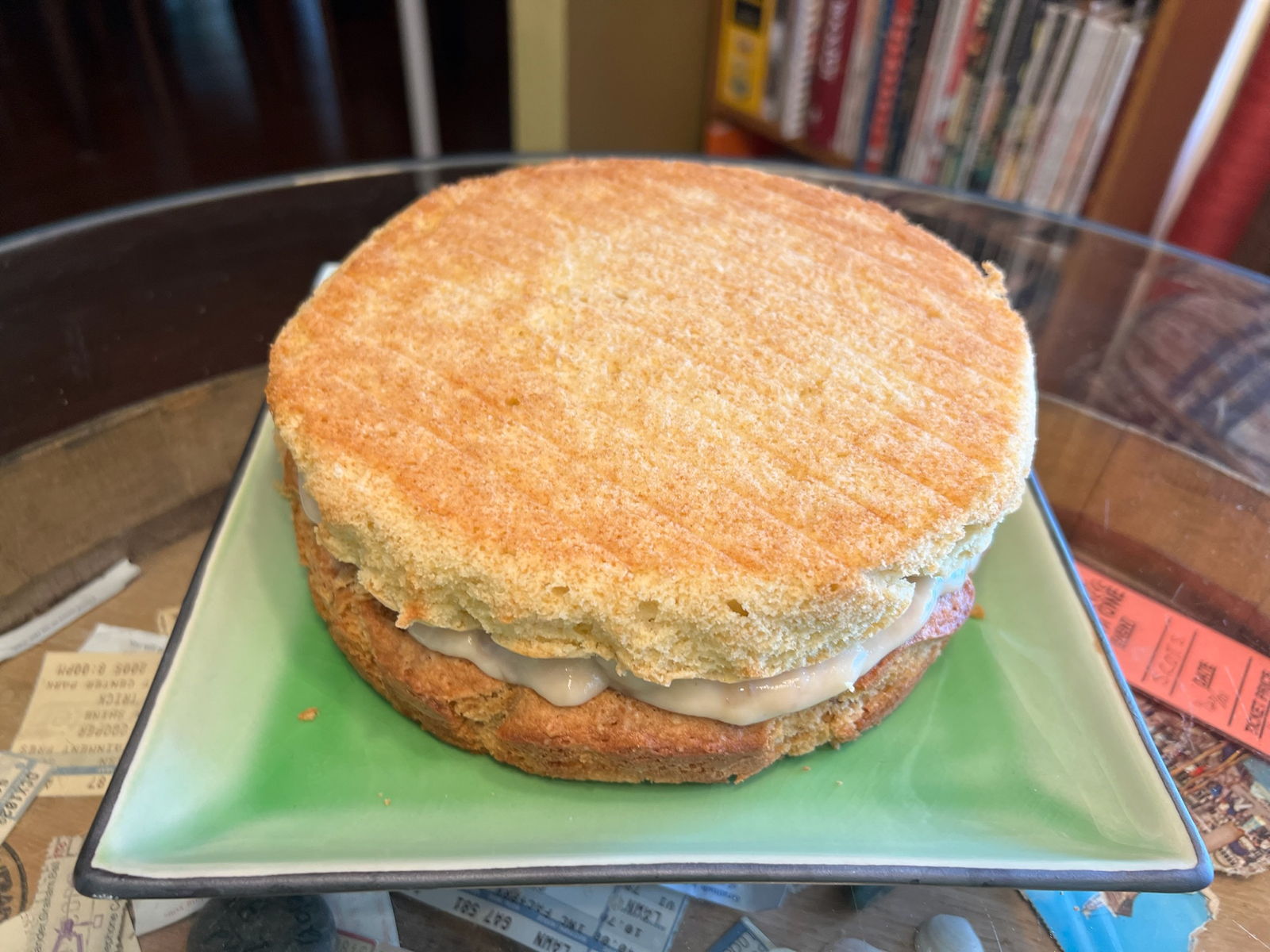
A layer cake using Rumford’s Gold Cake (along with a walnut pudding filling).
- The Brown Sugar Macaroons make about 32 macaroons; bake for about 8 minutes at 350°.
- The Date Sticks make about 24 sticks in a 9-⅓ by 13-½ pan; bake at 350° for about 30 minutes. I halved the recipe and used an 8x8 pan.
- The Potato Flour Muffins make twelve “muffins”, i.e., a standard muffin tin array’s worth; see post for substituting instant mashed potatoes for potato flour.
- For the Rumford Muffins, a previous owner changed baking powder to 3 teaspoons, shortening to 4 tablespoons, and eggs to 2. This is about halfway between Rumford Muffins and Rich Muffins. I have not tested this change.
- When making the Gold Cake, I mixed the butter in with the egg yolks and sugar, not after adding the flour. I also used sour milk. I made a half recipe in an 8-inch round cake pan, and it took about 15 minutes at 350°.
- In the General Rules for Cake and Cookie Making, “when beating egg-whites, add a pinch of salt”. This is not mentioned in Biscuits, Muffins, Rolls, Etc. I suspect, however, that you are still assumed to know this. And I keep forgetting to.
- The Hermits, the Gingerbread, the Spice Cake, and the Fruit Cake call for mixed spices. “Mixed Spice” is a term describing something very much like pumpkin spice; if you have that you can use it. Otherwise, a mix of cinnamon, nutmeg, and ginger will do fine. If you feel creative add in your preference of coriander, caraway, and cloves or whatever else you feel like using from your spice rack. A simple mixed spice can be made using an 8:4:2:1 ratio of cinnamon:nutmeg:ginger:cloves.
In response to Vintage Cookbooks and Recipes: I have a couple of vintage cookbooks queued up to go online.
The other two recipes in the ad were a coconut macaroon with gelatin and a potato coconut candy.
↑Mrs. Lily H. Wallace calls it “corn starch” with two words in the introduction. Whoever wrote the recipe instructions for the Parker House Rolls used “cornstarch” as one word.
↑One of the coolest things my mom used to have is a digital scale that measures in fractions rather than in decimals! Mine, however, measures in decimals and so requires that I do division.
↑The Gold Cake doesn’t call for creaming the butter, but in that recipe the butter is melted first.
↑
cookbooks
- Rumford Recipes for Cake and Cookie Making, Biscuits, Muffins, Rolls, Etc. at Lulu storefront (paperback)
- A print copy of the recipes featured in the two Rumford recipe sliders, combining Cake and Cooking Making with Biscuits, Muffins, Rolls, Etc.
- Rumford Recipes Sliding Cookbooks (PDF File, 2.8 MB)
- The recipes from the Rumford Company’s sliding Recipes for Cake and Cooking Making and Recipes for Biscuits, Muffins, Rolls, Etc., combined and indexed.
- Rumford Recipes Sliding Cookbooks (ePub ebook file, 2.5 MB)
- Recipes from the two Rumford Company sliding recipe cards, combined into an ebook.
- Rumford Recipes sliding pamphlets in action: Jerry Stratton at Mimsy@YouTube
- “To follow a recipe, the baker slid the inner sheet to the desired recipe and read the ingredients through a window in the sleeve, then turned the sleeve over to read the instructions through a window in the other side.”
- Rumford Slider parts (Zip file, 2.6 MB)
- The sleeves and sliders for the Rumford Recipes for Cake and Cooking Making slider and the Recipes for Biscuits, Muffins, Rolls, Etc. slider.
food history
- Quiet ovens and Australian rice shortbread
- What is a quiet oven? How do we translate old recipes? Executive summary: 325°; very carefully. Plus, two Australian recipes for rice shortbread as a test of my theory.
potato flour
- How to substitute for potato flour: PJ Hamel at King Arthur Baking Company
- “What to do when you run short.”
- Ingredient Weight Chart at King Arthur Baking Company
- “For best results, we recommend weighing your ingredients with a digital scale. A cup of all-purpose flour weighs 4 1/4 ounces or 120 grams. This chart is a quick reference for volume, ounces, and grams equivalencies for common ingredients.”
More cookbooks
- Cookbook publication year estimates I have made
- When I acquire a cookbook without a publication or copyright year, I use the advertisements and contributors to make a stab at the likely year of publication. This page provides those guesses in case it helps you date your own books.
- Refrigerator Revolution Revisited: 1937 Kitchen-Proved
- Refrigerators started to take off during Prohibition, and became ubiquitous following World War II. This Westinghouse refrigerator manual and cookbook gives us a glimpse at home refrigerator/freezers in the Great Depression.
- Four New Ices and an Ice Cream Cookery
- Philadelphia Ice Cream, Walnut Nougat, Lemon Cream Sherbet, and Cranberry Ice. Four more new no-churn ice creams and desserts for Summer 2025. And, a book collecting all my favorite no-churn ice creams if you’re interested!
- My Year in Food: 2024
- From Italy, to San Diego, to Michigan, and many points in between; and from 1876 up to 2024 with stops in the 1920s, this has been a great food year.
- Mrs. Winslow’s Domestic Receipt Book for 1876
- If this is what people were eating in 1876, they were eating very well. From coconut pie to molasses gingerbread to tomato jam, these are great recipes—albeit requiring some serious interpretation.
- 72 more pages with the topic cookbooks, and other related pages
More food history
- Using search engines to guess cookbook years
- Many cookbooks, especially community cookbooks and often advertising pamphlets, leave off the year. Often, however, there are solid clues in the text that narrow down when the book was published, through simple online searches.
- Cookbook publication year estimates I have made
- When I acquire a cookbook without a publication or copyright year, I use the advertisements and contributors to make a stab at the likely year of publication. This page provides those guesses in case it helps you date your own books.
- Refrigerator Revolution Revisited: 1937 Kitchen-Proved
- Refrigerators started to take off during Prohibition, and became ubiquitous following World War II. This Westinghouse refrigerator manual and cookbook gives us a glimpse at home refrigerator/freezers in the Great Depression.
- A Vicennial Meal for the Sestercentennial
- In 1776 we were too busy to write commemorative cookbooks. But in 1796 “Amelia Simmons, American Orphan” published the first known American cookbook. It’s a celebration of American foods, American values, and American economies.
- Mom’s High School Cooking Notebook, 1960
- My mother kept her high school recipe notebook for as long as I can remember. It was often on the kitchen counter when the counter was dusted with flour.
- 23 more pages with the topic food history, and other related pages
More Rumford Chemical Works
- Vintage cookbook reproductions, and gold cakes compared fifty years apart
- I’m going to start producing facsimiles of some of the vintage cookbooks I’m covering here, because some of them are wonderful, and also because it’s easier to read them in a larger format.

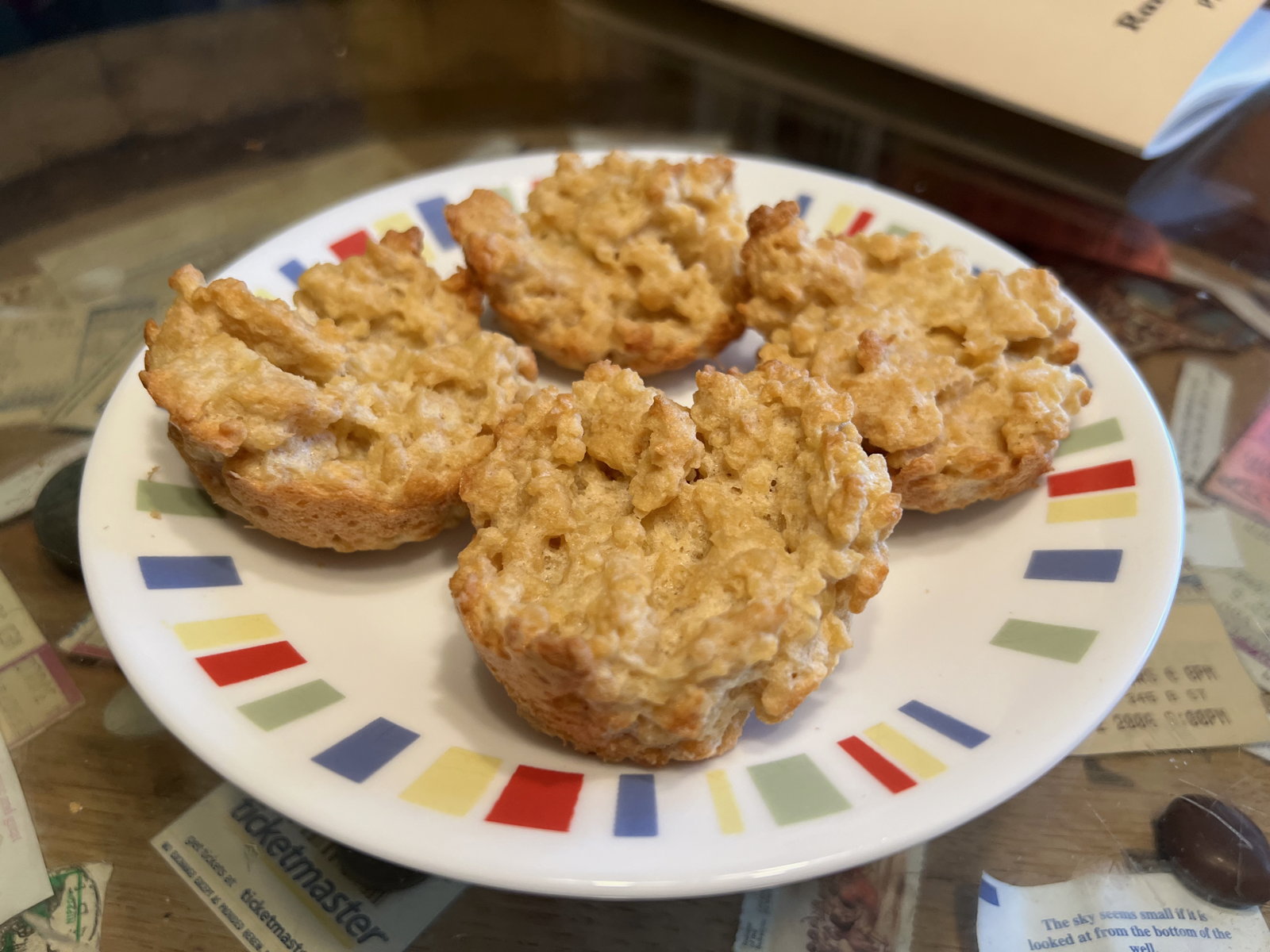
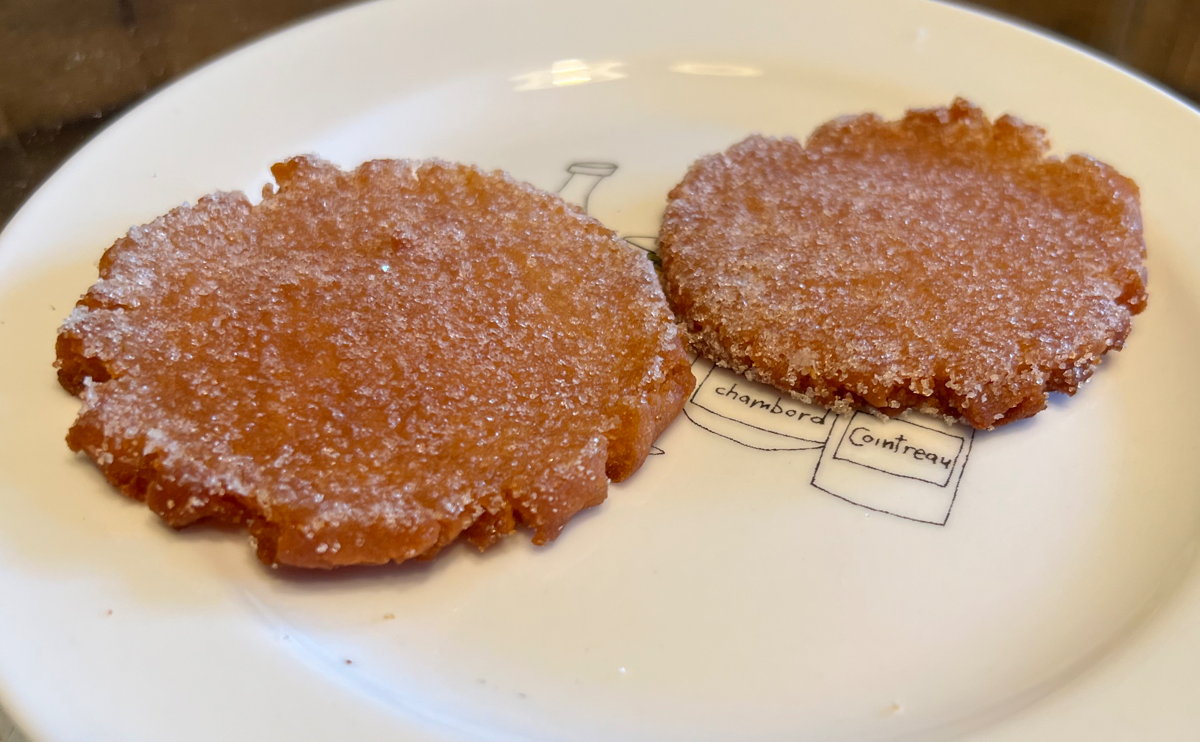
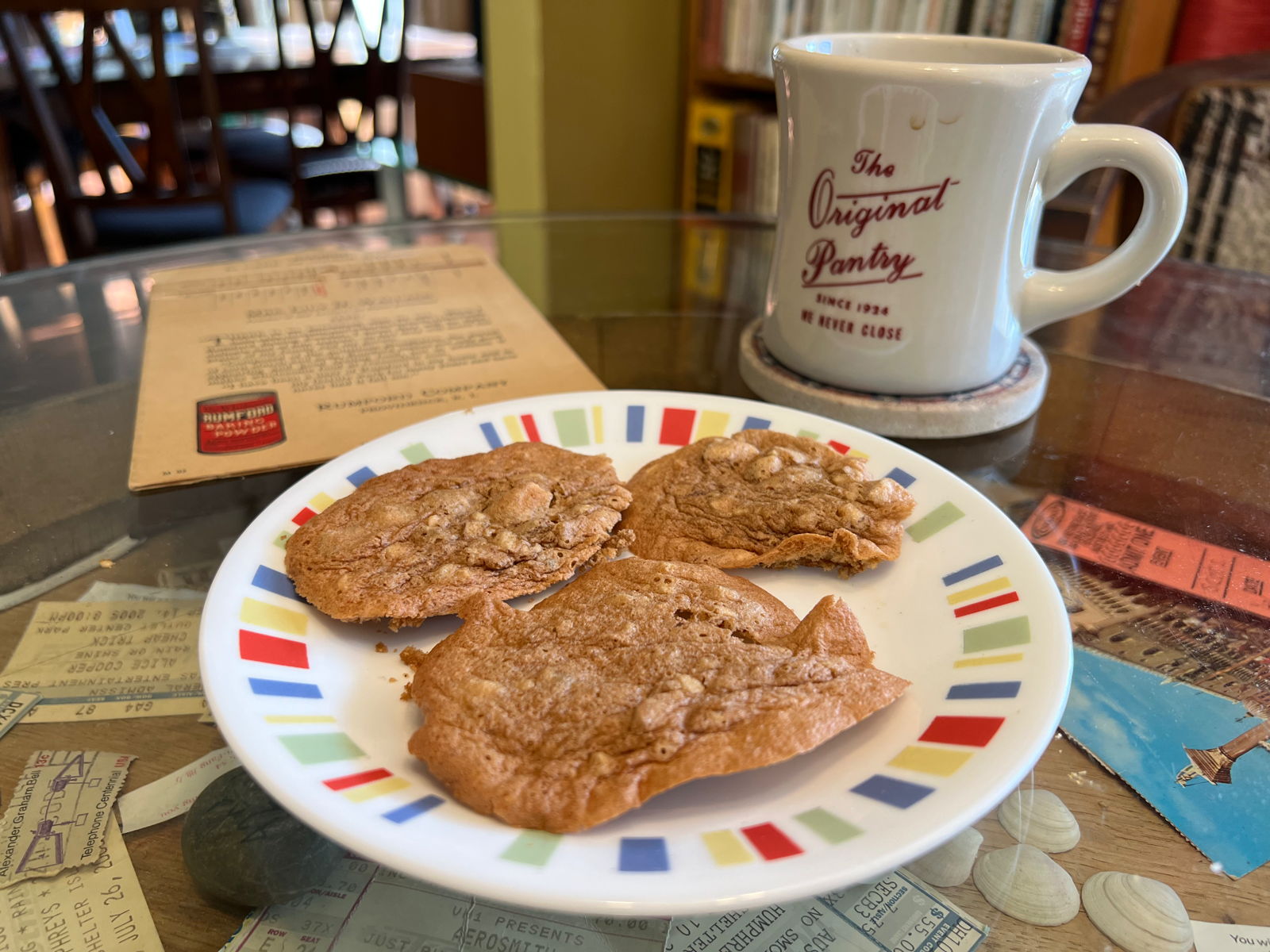
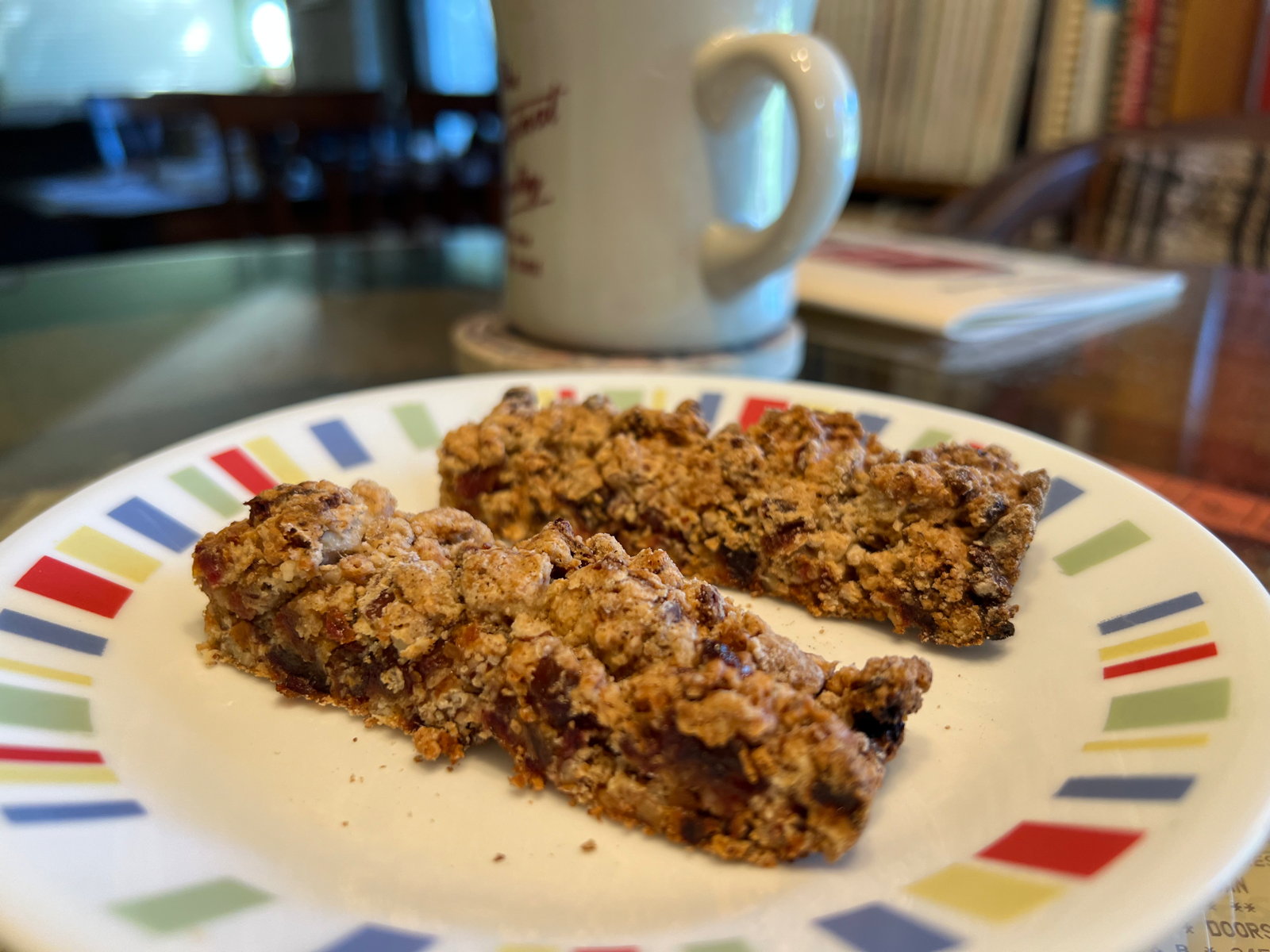
I have a math brain, so fractions to decimals and back again is easy for me. But my middle child who loves to bake does not have math brain. I found this table that helps him. Perhaps it can help you as well?
goodcooking.com/conversions/fractions.htm
Cyn B in STL, MO, USA at 2:10 a.m. December 5th, 2024
nBFrr